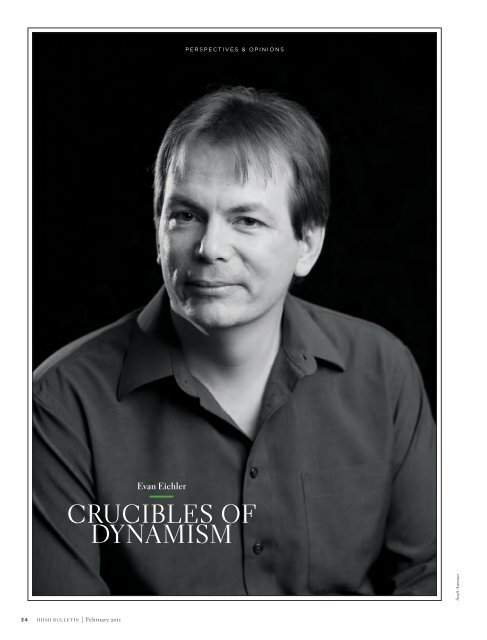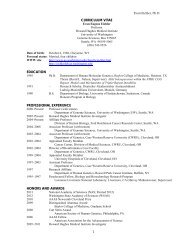HHMI Bulletin - Eichler Lab - University of Washington
HHMI Bulletin - Eichler Lab - University of Washington
HHMI Bulletin - Eichler Lab - University of Washington
- No tags were found...
You also want an ePaper? Increase the reach of your titles
YUMPU automatically turns print PDFs into web optimized ePapers that Google loves.
perspectives & opinionsEvan <strong>Eichler</strong>Crucibles <strong>of</strong>DynamismScott Areman34 h h m i b u l l e t i n | February 2o11
Puzzling pockets <strong>of</strong> redundancy account for about 5 percent <strong>of</strong> the human genome.<strong>HHMI</strong> investigator Evan <strong>Eichler</strong> found a way to interpret what is happening inthese areas <strong>of</strong> genetic repetition. The <strong>University</strong> <strong>of</strong> <strong>Washington</strong> researcher’s discoveryholds promise for our understanding <strong>of</strong> evolution and neurocognitive disease.We’re accustomed to thinking <strong>of</strong> evolution moving forward onebase pair at a time: A single nucleotide is replaced in the ribbon<strong>of</strong> our DNA and a gene is gradually transformed from one functionto another, or a disease emerges as the gene’s function isperturbed by these small stepwise changes. But there is another,parallel story unfolding within our genes, which, until recently,no one was able to easily read. To all appearances, it’s a moredramatic tale, with big events and rapid cataclysmic change.If the single-nucleotide substitution view <strong>of</strong> genetic advancesrelates a drawing room drama <strong>of</strong> our evolution, the story my labis uncovering is more like an action-adventure movie with multiplecar crashes. We think it is in this part <strong>of</strong> the story wherepr<strong>of</strong>ound changes took place in our evolution. The regions weexamine also appear to be a source <strong>of</strong> vulnerability to cognitivedisease, where big genetic errors can lead to intellectualdisability, autism, and schizophrenia, among other disorders.Although it was long apparent that duplication reignedin parts <strong>of</strong> our genome, there was no way to accurately analyzethese repeating elements. Our assays were based onhybridization, which relied on nucleotide probes to suss outcomplementary sequences, and such probes could not distinguishamong identical regions. We could not count themultiple copies <strong>of</strong> genes accurately, and we could not relategenetic changes to function.Using next-generation genetic sequencing and a new computationalalgorithm, my lab can now read about 70 percent<strong>of</strong> the chaotic chromosomal regions. The emerging pictureis <strong>of</strong> regions that are crucibles <strong>of</strong> dynamism, where lots <strong>of</strong>change happens quickly, both adaptive and deleterious.It appears that in the early common ancestor <strong>of</strong> humansand the great apes, certain genetic segments began hoppingaround the genome, inserting a duplicated version <strong>of</strong> themselvesat new locations. This pattern is rarely seen in othermammals. While mice, cows, and dog genomes carryrepeated genes, the repeats tend to follow one after the other.But our analysis <strong>of</strong> duplication in the genomes <strong>of</strong> macaque,orangutan, chimp, and human, published in Nature in 2005and 2009, showed that in the early common ancestor, repeatsmay be more than a million bases apart.When these hopscotching genes relocated—and we don’tactually know how or why—they picked up whatever geneticcode sat beside them, and then duplicated it and themselvessomewhere else along the genome. We call these hopscotchinggenes “core duplicons” because they seem to be at theheart <strong>of</strong> most regions <strong>of</strong> dynamic genetic change. From theirnew roost, the duplicons gathered additional flanking regions,and again continued their march along the chromosome,creating complex regions <strong>of</strong> duplications within duplicationsat many new locations.This architecture can create problems. Any time you haveidentical sequences, it’s easier to trick DNA’s recombinationmachinery. These repeating segments and the regions thatflank them are susceptible to unequal crossing-over events.That is, chromosome pairs, no longer perfectly aligned,swap genetic material unequally during meiosis, leading tobig changes when sperm and egg form. Some <strong>of</strong> the mostcommon genetic causes <strong>of</strong> epilepsy and autism are due torearrangements in these duplicated genes.When we looked more closely into these regions, we sawan incredible amount <strong>of</strong> variation between individuals andsome intriguing genes that have expanded in primate evolution.Although we have been studying these regions for15 years, the extent <strong>of</strong> genetic variation still surprises me.Of course, the big challenge now is to sort out just whatthis means, to link this more complex variability to phenotype—thatis, any observable traits. Early data suggest that thegenes within the core duplicons are expressed preferentiallyin neurons, particularly at sites <strong>of</strong> new nerve growth. Weknow that the large-scale copy number variation can explainabout 17 percent <strong>of</strong> the cognitive disability among childrenwe study from <strong>University</strong> <strong>of</strong> <strong>Washington</strong> Autism Center andother clinics around the world.One has to wonder why this kind <strong>of</strong> structural vulnerabilityhasn’t been selected against over the generations. The persistence<strong>of</strong> this genomic architecture suggests that these regionsalso confer important evolutionary benefit. I believe there’s abalancing act at play, especially considering the point in ourevolutionary history when the burst <strong>of</strong> duplications occurred.The circumstantial data argue for something fundamentalthat we’re missing about evolution and disease—that thisstructural variability contributes to what distinguishes us fromother primates. Is that the whole story <strong>of</strong> how we evolved?Absolutely not. But it is an important part that I think hasbeen overlooked. Over the next couple <strong>of</strong> years, we’ll eitherprove or disprove that hypothesis.Interview by Jenni LaidmaN. Evan <strong>Eichler</strong> is a pr<strong>of</strong>essor <strong>of</strong>genome sciences at the <strong>University</strong> <strong>of</strong> <strong>Washington</strong>.February 2o11 | h h m i b u l l e t i n35



